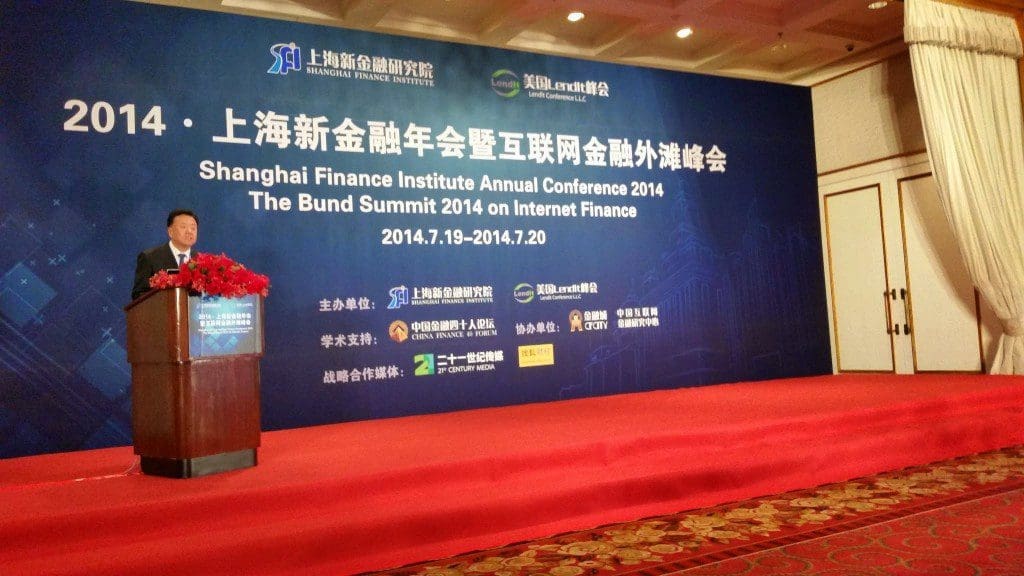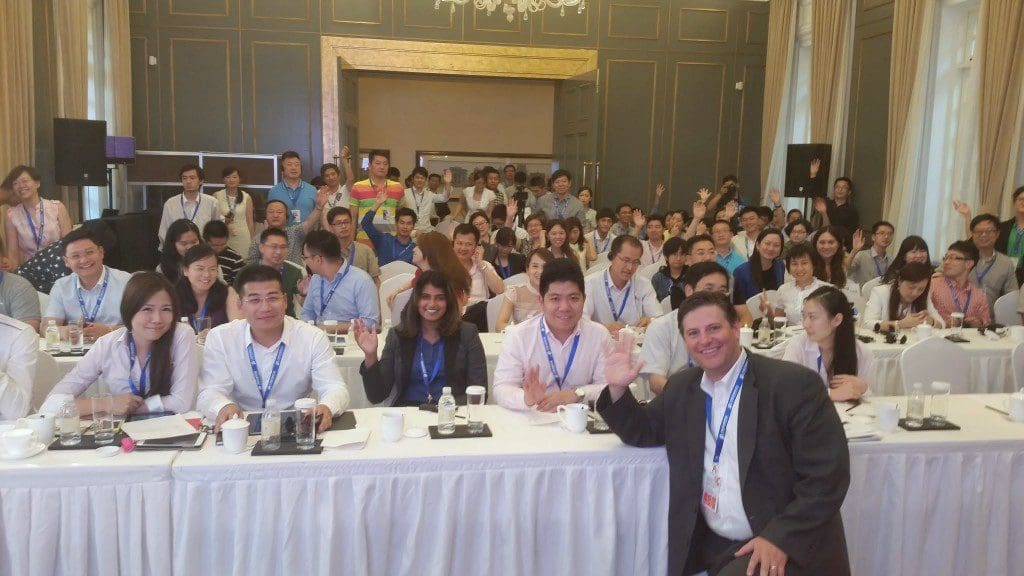[Editor’s note: This is a report from my Lend Academy partner and fellow LendIt co-founder, Jason Jones, who has been spearheading the expansion of LendIt into China. We co-hosted a successful p2p lending conference in Shanghai last weekend. I was intending to attend this event but decided against it at the last minute – instead I will be attending an event in Beijing next month. – Peter]
Beginning immediately after LendIt 2014 in May, I got to work planning LendIt Shanghai. Going into our inaugural Asian conference, we had modest expectations for attendance and interest, despite the fact that there were over 30 delegates from China at our San Francisco conference in May. I was the only member of the LendIt team to plan this conference and the only member to attend. Our goal was to measure interest in a P2P conference and set the stage for the future. To our surprise, LendIt Shanghai attracted over 400 attendees. It reminded me of our first conference in New York: I was overwhelmed with the incredible interest and excitement shown by the attendees. It was a great success!
The Chinese P2P lending market is huge, P2P has the attention of the Chinese society, and LendIt Shanghai has a chance to educate and connect China with the rest of the P2P lending world. Over the course of this next year, our entire LendIt team will be focused on integrating this conference with our US and European conferences, and turning the China conference into a major international exposition.
Here is what I learned about P2P lending by hosting LendIt Shanghai:
The Chinese Government Is Like the Parent to Society…. And to P2P Lending
The structure of our conference represented the way that (I think) society is structured in China. All of the VIP members of government and senior academic and business officials sat around a giant roundtable at the front of the venue and the audience sat behind the velvet rope. After the keynotes gave their speeches, the roundtable would discuss the topic and ask questions. The keynotes were heavy on regulation and policy making. This was how the first half of each day of the conference proceeded. For the second half of each day we broke into smaller groups, where we got down to business. It was like the parents set the rules in the morning and then the kids were allowed to go play in the afternoon. Their structure worked well, everything was very organized and it was helpful to hear from the regulators first.
Internet Finance is Very Important in China
The level of interest in P2P lending and Internet Finance is intense. Since the Chinese government is interested in Internet Finance and is considering setting policy, the media is very interested in covering the topic. I conducted approximately 30 media interviews and everyone wanted to understand US and UK government policy on P2P lending. They asked for best practices and explored how they could be implemented in China.
We were honored to have Mr. XIE Ping as a keynote speaker, who is a very warm and charming man. He is the Chief Investment Officer of China’s largest sovereign wealth fund and they call him the “Father of Internet Finance”. He provided fascinating insight into the virtues of P2P lending including how lenders feel a sense of empowerment by lending to other people and how small borrowers are provided access to credit for the first time. We also had Mr. Yan Qingmin, the Vice Chairman of the China Banking Regulatory Commission (CBRC) speak about how Internet Finance is a positive influence on society, along with the associated risks. It was a good balance of cautious optimism combined with the recognition that regulation is needed to support the continued growth of the system.
Chinese P2P Lending is Huge and it Feels Like it is About to Go into Hyper Growth Mode
It was interesting when Rhydian Lewis, the CEO of RateSetter, made a passing comment on our Global P2P panel that the UK market will grow at 100-200% annually for the next few years and then it will accelerate when the product reaches the mass market. It made me think that the same phenomenon is happening in China, but they are even closer to mass market adoption in China. While there is only about 2% penetration today, people believe that Internet Finance is going to be bigger than eCommerce and the extreme level of interest right now is going to push the market forward really fast, most likely faster than the US and the UK. I predict that P2P lending reaches the mass market in China before the US and UK. In the next one to two years the Chinese P2P marketplace is going to shift into hyper growth mode, especially if the government puts regulation in place.
Lack of a Credit Bureau Makes Lending Riskier
There was a lot of talk about China’s need to create a centralized credit bureau. They were very interested in hearing from Jeff Knott from Equifax, who spoke about the importance of credit bureaus and how electronic signatures make the process of collecting credit data significantly easier. They also were interested to hear from Sean Emery, the CEO of RainFin, about how they operate within the credit and regulatory policies set forth in South Africa. China has a mandate to create a centralized credit data warehouse by 2018. Mr. XIE Ping talked about the positive feedback loop where increased lending results in more data, which can be further analyzed and will result in increased lending. They are cautiously optimistic about the development of a credit bureau. In one encouraging exchange, Mr. TANG Ning, the CEO of CreditEase, which is the largest P2P firm in the world, agreed to provide his firms’ data to the newly established credit bureau. This move was very well received by the audience.
P2P Lending Market Structure is Still Rough Around the Edges
There are a lot of “best practices” that Lending Club has implemented that we take for granted. It became evident when I compared their business model to the Chinese models. I spent a lot of time identifying weaknesses and explaining some best practices:
They need custodians & bankruptcy remote structures: in the recent past, a few small Chinese platforms shut down and ran away with lenders’ money. As a result, the Chinese are very aware that they need third party custodians and other lender safeguards.
They are too reliant on guarantees: P2P platforms with guaranteed returns distort marketplace equilibrium and introduce unforeseen risks. The regulators want to slowly decrease the use of guarantees as the volume of credit data increases.
The “30 fraction” rule seems counterproductive: there is a rule in China that loans can only be fractionalized up to 30 times, which prevents loans from being reduced to smaller ticket sizes. This introduces more concentrated risk per borrower.
The individual investor/borrower rule prevents diverse funding sources: P2P platforms must match the type of lender and borrower. Individual borrowers can only take money from individual investors and institutional borrowers can only take money from institutional lenders. As a result, origination platforms are required to have a banking license in order to allow institutional investors to lend to individual borrowers. The US marketplace has a much more flexible structure, allowing origination platforms like Lending Club and Prosper to diversify their funding sources, which has lowered their cost of capital and improved borrower options. It has also accelerated innovation. We see the same emphasis in other dominions such as the UK, and I believe China would be well served to change this rule.
They are too focused on the investor at the expense of the borrower: There was a lot of focus on protecting the investor from fraud but little focus on offering an attractive rate to the borrower or protecting the borrower from fraud. The borrowers are the backbone of the industry.
The lack of transparency causes mistrust: At this time, none of the Chinese P2P firms make their loan files available for download. Since there is a lot of mistrust around the legitimacy of performance claims, I suggested that the origination platforms begin releasing their audited loan files as a first step. I encouraged every P2P firm to take the high road and make their platform transparent.
They need to build ecosystems: None of the Chinese P2P firms have established publicly available Application Programming Interfaces (“APIs”) for third-party integration. They should act like platforms making their marketplaces accessible, providing full historical data files, and providing technology APIs for connectivity. These best practices allow the ecosystem to build on top of the platforms.
Intense Competition Has Yielded Healthy Innovation in the Chinese P2P Lending Market
There are 1,000+ P2P firms in China and we tried to highlight the leaders at our conference. Due to the intense competition, each P2P firm must offer a differentiated product in order to survive. I saw great innovation taking place that may be applied to the US market. Here are a few highlights:
Lufax: Lufax is the fastest growing P2P firm growing at 1600% and trending towards US$3 billion in originations this year. They are a division of Ping An Insurance and they provide fully insured investments backed by the Ping An brand. This is a great example of an innovative insurance company with deep expertise in financial services applying their capabilities to a developing financial marketplace.
Dianrong: Dianrong was founded by Soul Htite, who is a co-founder and former CTO of Lending Club. Dianrong continues to introduce best practices into the Chinese market. In addition, they partnered with Century 21 real estate last week to launch P2P mortgages through Century 21’s Chinese network.
CrediEase: CreditEase is the largest P2P lending platform in the world and it has expanded beyond P2P into private wealth management. It is interesting to see how they integrate their P2P lending product with their other wealth management products.
Will Be Back Again Next Year!
Our little business development project turned into a huge success. Our partner, Shanghai Finance Institute (SFI), did an amazing job as our co-host and local partner. We would like to thank our 21 LendIt Shanghai guests including 11 panelist speakers and 3 keynote speakers, which represented 20% of the total number of speakers and close to 40% of the keynote speakers. I would also like to thank Tharon Smith, who helped to plan the conference and helped with translation. I would also like to thank Soul Htite, who encouraged us to launch a conference in China and who introduced us to SFI. Finally, I would like to thank all of the Chinese delegates who gave us a very warm welcome and made us feel like VIPs during our visit. LendIt Shanghai was a great event and I am honored to have had the chance to shine the spotlight on the world’s largest P2P lending market.




